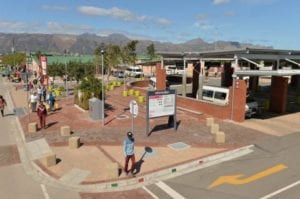
Nomzamo, a small township just outside of Strand in the Western Cape, can now boast a Public Transport Facility (PTF) that gives priority to the community’s needs.
The Nomzamo community hall and business centre were built some 12 years ago. At that time the taxi rank was simply a grass and gravel patch located between the community hall and Michael Street, which was being used informally by minibus taxis to load passengers.
Having identified the urgent need for the informal minibus-taxi rank to be upgraded, the City of Cape Town appointed SMEC South Africa in January 2013 to carry out the design and construction of the Nomzamo PTF.
The preliminary design was completed in July 2013, while construction of the facility was finalised in August 2015.
“The new facility has integrated several aspects of sustainability into its functionality,” Doug Calverey, SMEC South Africa, technical specialist: roads and highways, comments. “It has been planned to accommodate minibus-taxi movements in the most efficient manner.”
The commuter a number 1 priority
In addition, the commuter has been treated as the number one priority in terms of comfort and safety, so that conflicts between pedestrians and moving minibus-taxis are reduced.
The roadway along Michael Street, which passes through the minibus-taxi precinct, has been raised and paved with a grey interlocking concrete paver, so that drivers are made aware that they are entering a public transport area where pedestrians have priority.
Safe pedestrian crossings have been provided at strategic points, delineated in red brick pavers so as to stand out from the surrounding grey concrete or black asphalt.
The commuter loading and off-loading areas, as well as the pedestrian walkways, have all been designed with overhead canopies to ensure adequate protection against sun and rain.
Low walls and bollards under tree cover have been designed to double as seating opportunities and to prevent minibus-taxis from mounting the kerbs and parking in areas identified for the exclusive use of the commuter.
The buildings also include a manager’s office so that adequate management can be provided by the city to control the maintenance, cleaning and operation of this important public transport facility. This is critical, as the facility generates a huge volume of litter deposited by commuters.
Sustainable solutions
A wash bay has been constructed for two taxis with an overhead canopy and a separately metered water supply.
The wash bay features an underground oil separator that prevents oil and grease from entering the foul sewer system.
A photovoltaic (PV) system provides adequate electricity supply for 100% of the administration buildings and ablution block when the sun is shining.
The PV system can always be expanded in the future to include batteries in order to accommodate lighting at night.
“It is hoped that the Nomzamo community takes ownership of the facility and proper management control is implemented, so that this public open space can be used for the benefit of the entire community,”Calverey concludes.








